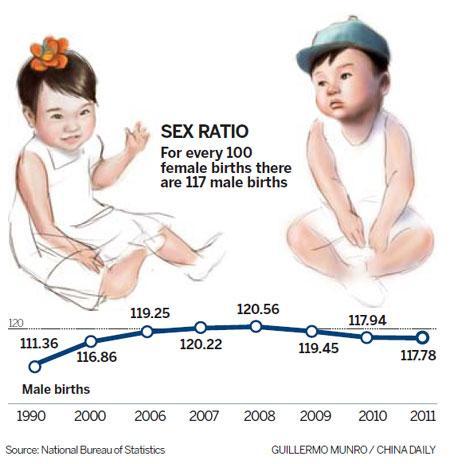| Videos | • Latest |
|
• Feature | • Sports | • Your Videos |
China sees decrease in male-to-female birth ratio gap

 0 Comment(s)
0 Comment(s) Print
Print E-mail CNTV, March 31, 2012
E-mail CNTV, March 31, 2012
The Population and Family Planning Commission has announced a decrease in the gap in the male-to-female birth ratio for a third consecutive year. But male babies are still outnumbering females by ten percent. So what are the consequences of this imbalance and what is the Chinese government doing to fix it?
 |
|
China sees decrease in male-to-female birth ratio gap. |
According to the National Bureau of Statistics, over 24 million marriageable males will still be single by 2020. Xiao Zhang is likely to be one of these unlucky men. He comes from a small village and is now a migrant worker in Beijing.
Xiao Zhang said, "I can't find a girl in my village. Also I have to spend one year of my income on a new home, or else no girl will marry me."
Ironically, the imbalance is rooted in the long-standing discrimination against girls in China.
But this big imbalance in the birth rate didn't appear until the 1980s, when ultrasonic technology allowed parents-to-be to identify the sex of the fetus while still in the womb. Since then, China has gradually become the country with the most imbalanced sex ratio for population under 15.
Zhang Yumei, vice director of Navy General Hospital, said, "The international SRB is around 106. But Chinese SRB has soared up. It's now 10 points higher than global average."
With fewer females in the upcoming generation, this is accelerating the ageing process and stands to make a negative impact on economic growth. Also, the shortage of marriageable females is to bring about a "marriage squeeze". A number of reports have told of young women being kidnapped and sold as forced brides in the Chinese countryside. The government has taken note of these dangerous trends and is putting a lot of effort into bolstering the social status of women.
Zhang Yumei, vice director of Navy General Hospital, said, "Non-medical sex identification and sex-selective abortion, the so-called Two Illegalities, are strictly prohibited. These measures have made the SRB go down for three consecutive years."
A series of laws and regulations have been adopted to protect women's rights and promote gender equality, including economic and political participation, education, property inheritance, marriage and old-age support.
Legislation is designed to eliminate direct causes of the rising SRB. But comprehensive and efficient countermeasures are needed to fight against sexual discrimination.






Go to Forum >>0 Comment(s)